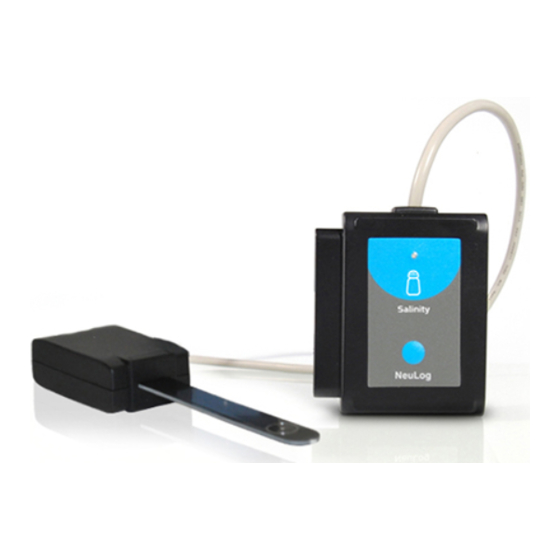
Advertisement
Quick Links
N
euLog salinity logger sensor
NUL-228
The NeuLog salinity sensor can be used for any science experiment or activity which
utilizes solutions that have a saline (salt) component such as in the fields of
Chemistry, Biology, Earth Science, Environmental Science, Biochemistry, Physics,
etc.
The sensor comes pre-calibrated so you can start experimentation right out of the box
using any of the following guides.
Just a few of the thousands of possible experiments that can be done with the NUL-
228 sensors are: Monitoring of ecological systems, chemical analysis and
identification, environmental health testing, water quality testing, chemical properties,
properties of electricity, etc.
The NeuLog salinity sensor can use any of the following units of measure:
Percentages (%): The total saline percentage out of the whole sample.
Parts per million (ppm): The number of salt molecules per million molecules.
Milligrams per liter (mg/L): The total mass of dissolved salts per liter of
volume.
Probe usage and care:
The probe has two flat electrodes with known surface areas and distance between
them. A signal is supplied to the electrodes and by testing the signal behavior, the
salinity of the solution is calculated.
General care:
Avoid touching the probes flat green surface if possible.
Never submerge the probe's or sensor's plastic body in any liquid.
Gently rinse the electrodes off with distilled water after each use and
between samples to avoid damage and contamination.
Handle and store with care to avoid damaging or chipping the electrodes.
NEULOG SALINITY LOGGER SENSOR GUIDE
Quick start procedure:
PC or Mac Computer
Materials needed:
NUL-228 Salinity Sensor
USB-200 USB Module
A USB to mini USB cable (which comes with the USB-200)
Your salinity sensor needs to be connected to a USB-200 module. The USB-200
module then connects to a computer via a USB to mini-USB cable. Please note that
you cannot plug the salinity sensor directly into the computer.
Resident PC software and browser based software can be downloaded for free at
www.NeuLog.com/dowload as well as a full software user guide. Note: Make sure not
to download and install both types of software, they will conflict on the computer.
Procedure:
1.
Install the NeuLog software
2.
Connect the USB-200 module to the PC or Mac
3.
Connect the salinity sensor to the USB-200 module (they directly plug
together). Please note there is no calibration required for this sensor.
4.
Open the NeuLog software.
5.
Once a salinity sensor logo appears on the left side of the screen the probe
has been automatically identified and you can begin experimentation.
If the salinity sensor is not automatically identified, click on the "Search for
6.
sensors" icon to find the sensor.
Select the "On-line experiment" button; this will open a graph below.
7.
Click on the "Module setup" button located on the salinity sensor icon in the
8.
module window to change the sensor settings if need be.
9.
Click on the experiment set up button to change the experiment settings if
need be (experiment duration for example).
10. The salinity sensor will give a live reading in the box to the left of the screen
while plugged in.
11. To run an experiment and collect data click "Run experiment".
12. To end data collection early, click "Stop experiment".
Advertisement

Summary of Contents for NeuLog NUL-228
- Page 1 NUL-228 PC or Mac Computer The NeuLog salinity sensor can be used for any science experiment or activity which Materials needed: utilizes solutions that have a saline (salt) component such as in the fields of ...
- Page 2 Your salinity sensor needs to be connected to a WIFI-201 module. The WIFI-201 Materials needed: module will create a closed NeuLog wifi network which will stream the NeuLog data to a device of your choosing. Once your device is wirelessly connected to the NeuLog ...
- Page 3 Resume from step 4. ability to store its own data due to an internal flash memory chip and micro-controller in each plastic NeuLog body. This technology allows the sensor to collect and then Included with sensor: store the digital data in the correct scientific units ( F, Lux, %, ppm, for example).
- Page 4 A: 850 St Paul Street, Suite 15, Rochester, NY 14605 P: 1.866.553.8536 Maintenance and storage: Never submerge the NeuLog plastic body in any liquid. Do not allow liquid into either the sensor’s or probe’s plastic body. After using the probe rinse with distilled water and then blot or let air dry.













Need help?
Do you have a question about the NUL-228 and is the answer not in the manual?
Questions and answers